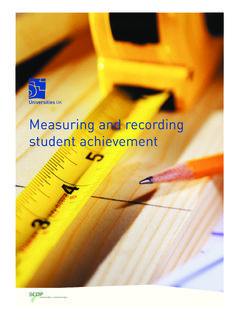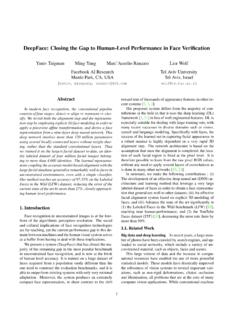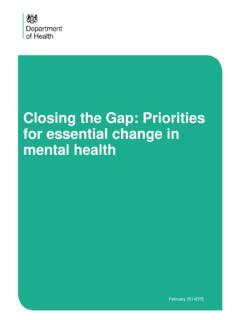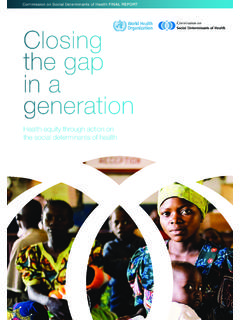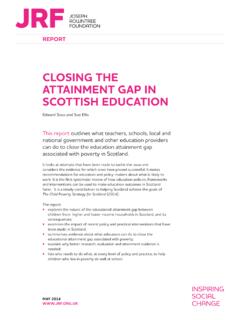Transcription of BAME student attainment UK universities closing the gap
1 BLACK, ASIAN AND MINORITY ETHNIC student attainment AT UK universities : #CLOSINGTHEGAPMAY 2019 CONTENTSF oreword by Baroness Valerie Amos, Director, I SOAS University of London Foreword by Amatey Doku, Vice-President Higher Education, II National Union of Students Executive summary 11: Introduction 42: Sector data on ethnicity and attainment 113: Contributory factors 164: Contributing factors identified by the calls for evidence 215: Providing strong leadership 276: Having conversations about race, and changing the culture 377: Developing racially diverse and inclusive environments 458: Getting the evidence and analysing the data on the attainment gap 569: Understanding what works 6310: Conclusions 74 Annexe A: Description of the project 76 Annexe B: Positive action and positive discrimination 79 Bibliography 80 FOREWORD BY BARONESS VALERIE AMOS, DIRECTOR, SOAS UNIVERSITY OF LONDONWhen the extent of the BAME attainment gap in universities was brought to my attention, I was shocked, because universities should be places where opportunity and aspiration come together.
2 Of course I knew that, given its extent in society, discrimination would exist in our universities . What I was not prepared for was the patchy approach to action to bring about change. Some universities have been slow in recognising the scale of the challenge and in committing to making the changes required. Others have made significant progress in narrowing the face significant challenges in terms of representation, pedagogy, curriculum reform and student experience. BAME students do not do as well at university compared with their White counterparts the latest statistics show a 13% attainment gap. BAME staff are poorly represented in both senior academic and university leadership roles: of 19,000 people employed as professors in the UK, only 400 are BAME women. In a typical gathering of 100 professors, 90 would be white and there would be just two BAME is this happening? In Britain, we are proud to have some of the best universities in the world attracting global talent, yet the data in this report shows that even when BAME students overcome the hurdles that prevent them getting to university in the first place, they do not have an equal chance at succeeding.
3 We are not operating a level playing is why I was pleased to be asked to lead on this project for universities UK (UUK), working with Amatey Doku, Vice-President for Higher Education from the National Union of Students. We started a nationwide conversation about the BAME attainment gap and how to address it. The report shows how structural inequality within universities has a profound effect on students ability to achieve. My thanks go to the students who participated in our evidence sessions and helped us to understand the pervasive and negative impact of discrimination on the student experience and their ability to achieve, and also to the university leaders, academics and university administrators who shared their experiences and perspectives. IBLACK, ASIAN AND MINORITY ETHNIC student attainment AT UK universities : #CLOSINGTHEGAPThis report shines a much-needed spotlight on what has been happening, and crucially provides advice on what needs to be done.
4 We cannot afford to be complacent. We need to take action now. None of this work would have been possible without the support and commitment of Amatey Doku, the staff at UUK and the vice-chancellors who participated in the advisory group. Thank AmosFOREWORD BY AMATEY DOKU, VICE-PRESIDENT HIGHER EDUCATION, NATIONAL UNION OF STUDENTSI used my first big speech as Vice-President Higher Education at the National Union of Students (NUS) to tell the sector that the BAME attainment gap was simply unacceptable and deeply unjust. Despite my tablet s numerous attempts to silence me (by promptly shutting down just after I started speaking), I was hugely grateful for the opportunity to address a large group of vice-chancellors at the UK Conference at Brunel University London in October 2017, putting this issue on the agenda. It s been a great pleasure since then to work with the UUK team and alongside Baroness Amos on this project: co-production has long been championed by NUS as key to a successful student experience, and I hope this sector-level replication provides a blueprint for further co-operation.
5 My fear on starting this process was that it would stir up some interesting conversations, articles and commentary, but ultimately have no long-lasting impact for BAME students. However, since I started in this role, some key things have changed in relation to the BAME attainment gap. The sector now accepts that there is a problem many more students IIBLACK, ASIAN AND MINORITY ETHNIC student attainment AT UK universities : #CLOSINGTHEGAP unions are aware that there is an issue and have prioritised it in their campaign work; the Office for Students (OfS) in England has set new targets for institutions to close their gaps and the issue has even been given a profile by the Cabinet Office and the government s Race Disparity Audit. If you include the establishment of the new Evidence and Impact Exchange at the OfS, a what works practice-sharing hub for the sector on related issues, and the tireless effort of activists and campaigners on the ground, we have a window of opportunity not just to continue to profile the issue but to make real change.
6 Our report and our recommendations must be viewed in that wider context, as not providing all the answers, but spurring that collective effort to turn the intent of many to change into real, meaningful action. This report would not have happened without the work of student activists and campaigners who made sure that this was on the agenda for NUS and allowed me to make it a clear priority for the Higher Education Zone for the first time in years. I d like to thank all the students and students unions that engaged with our surveys and shared their invaluable experiences at our roundtables. Finally, I ask university leaders, from whom strong leadership on these issues is essential, not to treat the BAME attainment gap as a numbers game. Data analytics and targets will be critical to ensuring that there is accountability and transparency, but we must never lose sight of the fact that we are dealing with the lives of individuals who face systematic discrimination from all parts of must not be complacent, but I m optimistic that if we take action, higher education can begin to play its part in the long-term project to dismantle racial inequality across British society.
7 Amatey Doku IIIBLACK, ASIAN AND MINORITY ETHNIC student attainment AT UK universities : #CLOSINGTHEGAPEXECUTIVE SUMMARYIn recent years, progress has been made in widening university access and participation to disadvantaged and underrepresented groups of students, but not every student benefits equally from their UK university experience. Substantial inequalities persist throughout the student lifecycle between students of different socio-economic and ethnic inequalities in higher education mirror those in wider UK society. Broader political and social realities are evident on campuses affecting the experiences and actions of staff and students. As other organisations have dealt with the injustices and inequalities faced by ethnic minorities, the higher education sector has fallen behind other parts of the education sector, the NHS and local government in addressing these inequalities. A student s race and ethnicity can significantly affect their degree outcomes.
8 Of the disparities that exist within higher education, the gap between the likelihood of White students and students from Black, Asian or minority ethnic (BAME) backgrounds getting a first- or upper-second-class degree is among the most stark 13% among 2017 18 graduates. The sector must partner meaningfully with students and robustly demonstrate its commitment to addressing the BAME attainment gap. Many universities have made a considerable effort to address this gap over several years with collaborative work between university leaders, staff and students unions, but there is still a long way to go. Eliminating these attainment differentials and transforming the university experience for BAME students will require sustained work from across the higher education UK (UUK) and the National Union of Students (NUS) have consulted with students, staff and vice-chancellors to identify the fundamental barriers to racial equality. This report and its recommendations aim to break down these barriers and accelerate sector-wide progress towards eliminating BAME attainment gaps.
9 13%'gap between the likelihood of white students and students from BAME backgrounds getting a 1st or a 2:1 degree classification1 BLACK, ASIAN AND MINORITY ETHNIC student attainment AT UK universities : #CLOSINGTHEGAPUUK and NUS engaged with the higher education sector and external organisations from June to December 2018 through: two online calls for evidence with over 100 respondents; six regional roundtable evidence sessions with over 160 participants; institutional case studies; and input from a vice-chancellors working group. In total, 99 universities and students unions contributed to this report. We ask universities to adopt the guidance in this report and commit to transformational, university and sector-wide change. Through our engagement, the sector identified five of the most significant steps needed for success in reducing attainment differentials, which we ask universities to consider as a framework for accelerating progress.
10 Providing strong leadership: University leaders and senior managers need to demonstrate a commitment to removing the BAME attainment gap and lead by example. UUK and NUS have created a checklist (see table 1 in section 5) for university leaders to draw upon when considering how to address their institution s attainment gap. Having conversations about race and changing the culture: universities and students need to create more opportunities to talk directly about race, racism and the attainment gap and to identify what students think is causing it. A change in culture is needed alongside a clear institutional message that issues of race are embedded within wider strategic goals. Developing racially diverse and inclusive environments: University leadership teams are not representative of the student body and some curriculums do not reflect minority groups experiences. A greater focus is needed from universities , working with their students, on ensuring that BAME students have a good sense of belonging at their university, and on understanding how a poor sense of belonging might be contributing to low levels of engagement and progression to postgraduate study.
